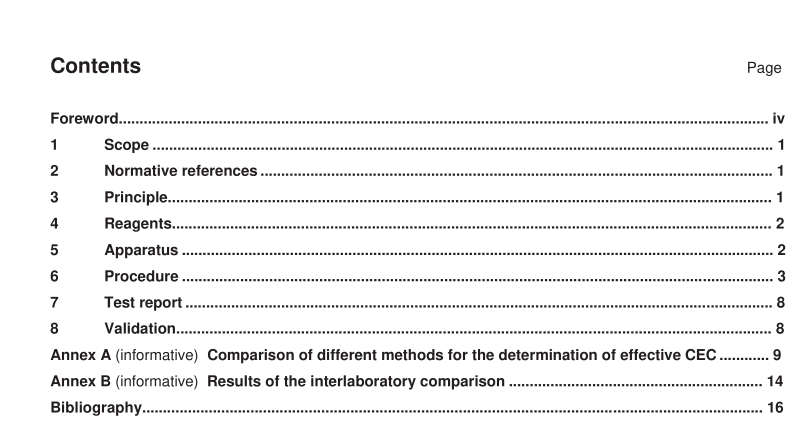BS EN ISO 23470 pdf download

BS EN ISO 23470 pdf download Soil quality — Determination of effective cation exchange capacity (CEC) and exchangeable cations using a hexamminecobalt trichloride solution
This International Standard is applicable to all types of air-dried soil samples which have been prepared inaccordance with ISO 11464.
References and results of the comparison with other methods (barium chloride, ammonium acetate) are givenin Annex A.
2Normative references
The following referenced documents are indispensable for the application of this document.For datedreferences,only the edition cited applies. For undated references,the latest edition of the referenceddocument(including any amendments) applies.
ISO 11464,Soil quality — Pretreatment of samples for physico-chemical analysis
3Principle
Cations retained by a soil sample are exchanged with the hexamminecobalt ions of an aqueous solution, withshaking for 60 min ± 5 min at a temperature of 20 C ±2°C.The CEC is obtained by difference between theinitial quantity of hexamminecobalt in solution and the quantity remaining in the extract after the exchangereaction. The measurement of hexamminecobalt concentration in the extract can be performed by directspectrophotometric measurement,or by the determination of total ammonium nitrogen or total cobaltconcentrations.
The quantities of exchanged cations are determined on the same extract using spectrometric methods, suchas inductively coupled plasma atomic emission spectrometry (ICP-AES).
NOTE1 Exchangeable acidity can also be measured in the hexamminecobalt extract.
NOTE2 When exchangeable cations are held in micropores into which ammonium ions but not hexamminecobalt ionscan enter, the CEC and exchangeable cation values determined with this method may be smaller than those determinedby the ammonium acetate method. This has been observed in some soils containing allophane and imogolite, for examplesoils developed on volcanic rocks.
4 Reagents
Only reagents of recognized analytical quality shall be used.
4.1 Distilled or demineralized water, exempt from the elements under analysis and having a conductivity of less than 0,5 µS·cm −1 .
4.2 Hexamminecobalt trichloride [Co(NH 3 ) 6 Cl 3 ], 0,016 6 mol·l −1 solution.
Dissolve, to within a milligram, 4,458 g of hexamminecobalt trichloride in a volumetric flask containing 700 ml of distilled water (4.1). Make up to volume and mix.
NOTE Hexamminecobalt trichloride can be purchased from Sigma-Aldrich or Fluka. 1)
4.3 Anti-bumping granules (e.g. pumice stone in grain form, glass beads).
4.4 Boric acid (40 g·l −1 solution).
4.5 Tashiro indicator.
Dissolve 2,0 g of methyl red and 1,0 g of methylene blue in 1 000 ml of 95° ethanol.
4.6 Phenolphthalein.
Dissolve 1 g of phenolphthalein in 1 000 ml of 95° ethanol.
4.7 Sodium hydroxide solution, 33 % (ratio of mass to volume).
4.8 Sulfuric acid (H 2 SO 4 ), 0,025 mol·l −1 standard volumetric solution.
4.9 Ammonium sulfate, for analysis.
4.10 Stock solutions of Al 3+ , Ca 2+ , Fe 2+ , K + , Mg 2+ , Mn 2+ , Na + , 1,000 g·l −1 .
These solutions are supplied with a certified composition from a reputable source and are checked on a regular basis.
5 Apparatus
Usual laboratory apparatus and glassware, and in particular:
5.1 Analytical balance, the weighing uncertainty range of which will not exceed ± 0,1 % of the test portion mass.
5.2 Containers for shaking, tightly stoppered, rigid or non-rigid wall, having a volume between 75 ml and 100 ml.
5.3 50 ml distributor, set at ± 0,25 ml of the delivered volume.









